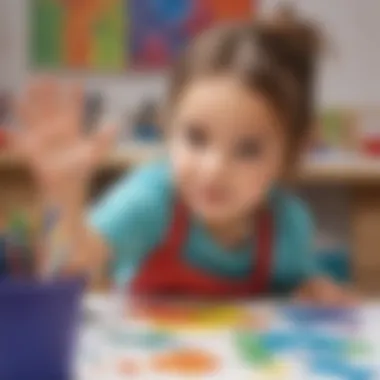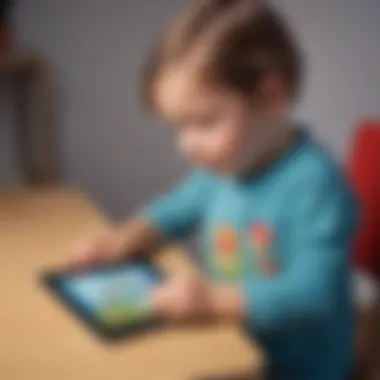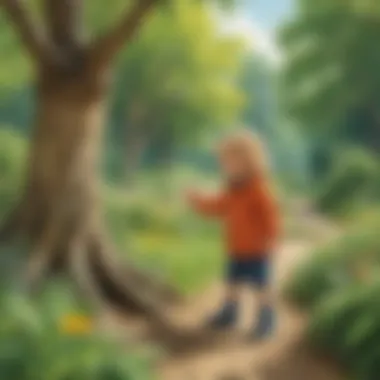Discovering Stimulating Learning Activities for Four-Year-Olds to Enhance Cognitive Development


Creative Activities
Unlocking the potential of a child's mind at the age of four is a delicate yet rewarding endeavor. Engaging them in creative activities opens a gateway to cognitive development and a love for learning that lasts. Encouraging children to explore artistic expressions through craft ideas can fan the flames of curiosity and innovation. Simple yet impactful ideas like making paper airplanes or creating pasta art can ignite their imagination and hone their fine motor skills. A step-by-step guide accompanying each activity empowers parents to facilitate these projects effectively. By delving into the educational value of each task, we can grasp how these engagements enhance problem-solving skills, spatial awareness, and patience in these young minds.
Fun Quizzes
Imbuing learning with an element of fun is paramount in captivating the attention and interest of preschoolers. Fun quizzes offer a dynamic way to introduce new concepts and reinforce existing knowledge. Diverse quiz topics ranging from animals and colors to numbers and shapes cater to the varied interests of four-year-olds. By incorporating multiple-choice questions, true or false statements, and interactive puzzles, these quizzes stimulate critical thinking and memory retention. This approach not only tests their understanding but also solidifies the information in a playful and engaging manner. Known as ElemFun, these quizzes serve as valuable tools for knowledge reinforcement and a playful way to consolidate learning.
Fact-Based Articles
Navigating the vast sea of information can be daunting, especially for young learners eager to absorb knowledge. Fact-based articles curated for four-year-olds offer a structured and engaging resource for exploration. Covering a myriad of topics from the wonders of space to the habits of animals, these articles present complex information in a digestible and captivating format. By infusing storytelling elements and interactive visuals, children are drawn into the world of facts and discovery. The incorporation of additional resources such as links to educational videos or interactive games enhances the learning experience, encouraging further investigation and expanding their understanding of the world around them.
Introduction
Understanding the Importance of Learning Activities for Four-Year-Olds
Learning activities tailored for four-year-olds play a pivotal role in their holistic development. These activities not only offer intellectual stimulation but also nurture social skills essential for their growth. Starting with the Developmental Benefits of Engaging Activities, we witness how these activities lay the foundation for well-rounded individuals. By recognizing the key characteristic of engaging activities, we understand why they are a preferred choice for the target audience of this article. Despite minor nuances, the benefits of engaging activities far outweigh any perceived disadvantages.
Digging deeper, Promoting Cognitive Growth through activities enriches the mental capacities of young children. A detailed insight into the distinctiveness of cognitive growth enhancement showcases why this aspect is imperative in the developmental journey. Its unique approach and demonstrable advantages highlight its essential role in the educational landscape, especially for four-year-olds. The holistic advantages it offers strongly outweigh any inadvertent drawbacks.
Equipping four-year-olds with Enhancing Social Skills is equally paramount, fostering empathy, communication, and teamwork from a tender age. Unpacking the essence of social skill development sheds light on why it is a sought-after feature in learning activities. The merits of social skills enhancement are profound, with minimal downsides observed in the context of this enriching article.
Overview of Age-Appropriate Activities
Tailoring activities specifically to four-year-olds requires meticulous planning and consideration. Each activity is tailored to embrace the cognitive capacities and interests of these young learners fully. Understanding Tailoring Activities to Four-Year-Olds entails exploring the nuances of personalizing experiences for optimal engagement. At the core of this customization lies the key characteristic of adaptability to the child's developmental stage, making it a prominent choice for our target audience. The advantages of such personalized experiences significantly outweigh any negligible drawbacks.
Moreover, implementing Considerations for Engagement while designing activities ensures a seamless and immersive learning journey for four-year-olds. Delving into the critical elements of engagement provides insights into why it is crucial for the educational experience. The distinctive features of engagement considerations enhance the overall effectiveness of activities, highlighting its pivotal role in this narrative. The benefits garnered far outweigh the minor constraints, making it an indispensable aspect of crafting engaging learning experiences.
Educational Games
In this section, we delve into the realm of Educational Games, focusing on the pivotal role they play in shaping the educational journey of four-year-olds. These games serve as powerful tools for cognitive development, enhancing critical thinking, problem-solving skills, and overall learning capacity. By engaging with Educational Games, children not only acquire knowledge but also foster a sense of curiosity and a love for learning that lasts a lifetime.


Interactive Learning Games
Puzzle Games:
Puzzle Games stand out as a cornerstone of interactive learning, offering children a unique blend of challenge and entertainment. The intricate nature of puzzles stimulates the brain, encouraging spatial awareness, pattern recognition, and logical reasoning. With Puzzle Games, youngsters learn to strategize, improve hand-eye coordination, and boost their concentration levels. While some puzzles may pose initial difficulties, overcoming them instills a sense of accomplishment and boosts self-esteem.
Memory Matching Games:
Memory Matching Games hold a special place in the educational landscape, sharpening memory retention and enhancing cognitive functions. These games aid in improving recall abilities, attention to detail, and short-term memory. By matching pairs, children not only exercise their brains but also learn to focus, observe, and remember patterns. Memory Matching Games are not only enjoyable but also serve as effective tools for developing essential cognitive skills.
Alphabet and Number Games:
Alphabet and Number Games offer a fundamental yet engaging approach to learning letters, numbers, and basic concepts. Through these games, children practice letter and number recognition, phonics, and basic arithmetic in a fun and interactive manner. By associating letters and numbers with gameplay, kids develop early literacy and numeracy skills. Alphabet and Number Games lay the groundwork for future academic success while making the learning process enjoyable and memorable.
Outdoor Learning Activities
Venturing outdoors opens up a world of exploration and discovery for four-year-olds, providing a hands-on approach to learning in a vibrant natural setting. Outdoor learning instills a sense of wonder, curiosity, and connection to the environment, enhancing cognitive development and physical well-being. Through outdoor activities, children engage their senses, refine motor skills, and cultivate an appreciation for nature, fostering holistic growth and fostering a sense of environmental stewardship.
Nature Scavenger Hunts:
Nature Scavenger Hunts combine excitement and education, encouraging children to explore the outdoors and discover hidden treasures. These hunts promote observation skills, critical thinking, and teamwork as youngsters search for clues and items in nature. By embarking on a scavenger hunt, kids not only learn about different flora and fauna but also develop problem-solving abilities, resilience, and collaboration skills. Nature Scavenger Hunts immerse children in nature's wonders, sparking a sense of curiosity and adventure.
Outdoor Obstacle Courses:
Outdoor Obstacle Courses inject a dose of thrill and physical activity into the learning experience, challenging children to overcome various obstacles while boosting their motor skills, coordination, and physical fitness. These courses test agility, balance, and perseverance, fostering resilience and determination. By navigating through obstacles, kids enhance their problem-solving abilities, spatial awareness, and risk assessment in a safe and enjoyable outdoor setting. Outdoor Obstacle Courses offer a holistic approach to learning, combining physical exercise with cognitive development and fun.
Sensory Exploration:
Sensory Exploration invites children to engage with the world around them through their senses, cultivating sensory awareness, creativity, and emotional intelligence. By exploring different textures, sounds, smells, and sights, youngsters develop sensory vocabulary, fine-tune sensory processing, and enhance spatial awareness. Sensory activities promote relaxation, focus, and self-regulation, providing a calming outlet for self-expression and introspection. Through sensory play, children learn to appreciate sensory inputs, manage stimuli, and express themselves in diverse ways, enriching their overall learning experience.
Creative Arts and Crafts
In this article, the focus is on the significance of Creative Arts and Crafts in the developmental journey of four-year-olds. Creative Arts and Crafts activities play a crucial role in fostering essential skills such as creativity, fine motor skills, hand-eye coordination, and self-expression. By engaging in artistic endeavors, children can explore their imagination, enhance problem-solving skills, and boost their confidence. Moreover, Creative Arts and Crafts provide a platform for emotional expression, allowing children to communicate their feelings and ideas non-verbally. Creating art helps young minds develop sensory perception and refine their cognitive abilities, laying a strong foundation for future learning pursuits.


Exploring Artistic Expression
Finger Painting: Finger Painting stands out as a quintessential activity in the realm of Creative Arts and Crafts for young children. This tactile and sensory experience not only encourages artistic expression but also promotes sensory exploration and fine motor skill development. The unique texture of finger paints enables children to experience art hands-on, stimulating their tactile senses and encouraging them to create without boundaries. Finger Painting fosters creativity and self-expression in a free and unrestricted manner, making it a popular choice in nurturing young artists. While finger painting allows children to explore colors and textures freely, it can get messy, requiring supervision and setup considerations to ensure a smooth artistic experience.
Playdough Creations: Playdough Creations offer children a versatile medium to express their creativity and imagination. The malleable nature of playdough allows four-year-olds to sculpt, shape, and design objects based on their whims and fancies. Through this hands-on activity, children enhance their fine motor skills, spatial awareness, and sensory perception. Playdough Creations stimulate problem-solving abilities and boost cognitive development as children experiment with different shapes and forms. One of the key benefits of playdough is its reusability, providing children with endless opportunities for exploration and invention. However, supervision is essential to ensure the safe and appropriate use of playdough, addressing any concerns regarding ingestion or misuse.
Collage Making: Collage Making serves as a dynamic avenue for artistic expression and visual storytelling. By combining various materials such as paper, fabric, and found objects, children can create unique compositions that reflect their individuality and creativity. Collage Making allows four-year-olds to explore different textures, patterns, and colors while honing their fine motor skills and hand-eye coordination. This activity encourages children to make connections between elements, fostering creative thinking and innovative expression. The process of collage-making empowers children to think outside the box, experiment with diverse materials, and develop their visual literacy. However, adult guidance may be necessary to offer support in selecting appropriate materials and ensuring a safe work environment for collage-making sessions.
Music and Movement Activities
Music and Movement Activities play a crucial role in the holistic development of four-year-olds. This section focuses on engaging children in rhythmic adventures that stimulate both their physical and cognitive abilities. By incorporating music and movement into educational settings, children experience enhanced sensory perception and motor skills development. These activities also promote creativity and self-expression, nurturing a well-rounded approach to learning.
Rhythmic Adventures
Dance Parties
Dance Parties offer a vibrant way for children to engage in physical activity while expressing themselves through movement. The dynamic nature of Dance Parties encourages children to improve coordination and balance, contributing to their overall physical development. These interactive sessions not only enhance motor skills but also promote social interaction and collaborative play among peers.
Musical Chairs
Musical Chairs present an exciting challenge that combines music and movement, fostering quick thinking and physical agility in children. The element of competition in Musical Chairs adds a thrilling aspect to the activity, keeping children engaged and enthusiastic. This game not only hones physical reflexes but also teaches children valuable lessons in sportsmanship and fair play.
Singing Games
Singing Games introduce a melodic component into music and movement activities, enhancing auditory skills and rhythm awareness in children. These games provide a platform for creative expression through song and encourage children to explore different vocal tones and pitches. By incorporating singing into play, children experience cognitive benefits while enjoying the pleasures of musical exploration.
Yoga and Mindfulness for Kids
Gentle Yoga Poses
Gentle Yoga Poses aid in promoting flexibility, balance, and body awareness among children. The calming nature of these poses allows children to engage in mindful movements that encourage relaxation and inner focus. Through practicing gentle yoga, children develop concentration skills and emotional regulation, fostering a sense of inner peace and well-being.
Breathing Exercises


Breathing Exercises play a pivotal role in helping children manage stress and cultivate mindfulness. These exercises teach children how to control their breathing patterns, promoting relaxation and reducing anxiety levels. By incorporating deep breathing techniques, children learn to channel their emotions effectively, enhancing their self-regulation abilities.
Relaxation Techniques
Relaxation Techniques offer children a toolbox of strategies to unwind and de-stress in a fast-paced world. From progressive muscle relaxation to guided imagery, these techniques empower children to find calmness and tranquility amidst daily challenges. By integrating relaxation practices into their routine, children can alleviate tension and improve their overall well-being.
Science and Nature Exploration
In the realm of early childhood education, Science and Nature Exploration stands as a fundamental pillar, offering young minds a gateway to the wonders of the natural world. This section embarks on a journey into the realm of hands-on experiences that cultivate curiosity, critical thinking, and environmental awareness in four-year-olds. Through immersive encounters with scientific phenomena and the exploration of nature's intricate beauty, children foster a deep appreciation for the world around them.
Hands-On Science Experiments
Magic Milk Experiment
The Magic Milk Experiment exemplifies the allure of combining simple household items to create captivating visual effects. By introducing dish soap to a surface of milk generously sprinkled with food coloring, children witness mesmerizing swirls of color patterns emerge. This experiment not only captivates young learners with its magical appearance but also serves as a gateway to understanding concepts such as surface tension and molecular interaction. Its accessibility and ability to engage multiple senses make it a popular choice that seamlessly integrates play with learning. However, its limitation lies in the transient nature of the effects, requiring swift observation and discussion.
Water Sensory Play
Water Sensory Play offers a holistic sensory experience, engaging children in exploratory play that stimulates their tactile, visual, and auditory senses. Through activities like splashing, pouring, and observing objects float or sink, youngsters develop their understanding of basic scientific principles such as buoyancy and volume. The versatility of water as a medium for learning allows for endless variations in activities, from simple water table experiments to more complex investigations like ice melting explorations. While its benefits in promoting sensory development are universal, considerations must be made for safety and supervision during water play to avoid accidents and mess.
Seed Planting
The act of Seed Planting introduces children to the marvels of growth and life cycles, instilling a sense of responsibility and connection to nature. By nurturing seeds into plants through watering, sunlight exposure, and observation, young learners witness firsthand the transformative journey from seed to sprout. This hands-on experience not only fosters botanical knowledge but also cultivates patience, attentiveness, and care in children. The opportunity to witness tangible results of their efforts instills a sense of achievement and environmental stewardship. However, challenges may arise in maintaining consistent care for the plants, emphasizing the importance of ongoing supervision and guidance in this activity.
Outdoor Nature Walks
Immersing in Outdoor Nature Walks provides four-year-olds with unparalleled opportunities for sensory engagement, physical activity, and environmental discovery. This section delves into the realm of nature exploration, encouraging children to observe, question, and appreciate the biodiversity surrounding them. Through activities like bird watching, bug hunts, and plant identification, young explorers develop their observation skills, ecological awareness, and appreciation for the interconnectedness of all living beings.
Bird Watching
Bird Watching invites children to embark on a journey of discovery, enabling them to observe avian species in their natural habitats. By honing their observation skills, listening for bird calls, and recognizing distinct plumage patterns, young bird enthusiasts deepen their knowledge of ornithology and habitat diversity. The benefits of bird watching extend beyond mere observation, fostering patience, respect for wildlife, and an understanding of ecosystem dynamics. Nevertheless, challenges such as bird identification and unpredictable bird behavior may require guided assistance to enhance the learning experience.
Bug Hunt
The Bug Hunt activity entices children to explore the miniature worlds of insects, arachnids, and other invertebrates dwelling in natural settings. By turning over rocks, inspecting foliage, and peeking under logs, young explorers uncover a plethora of fascinating creatures, honing their observation and classification skills. The hands-on nature of bug hunting encourages children to overcome fears, develop a curiosity for entomology, and understand the ecological roles of insects. Despite its enriching educational value, considerations must be taken to ensure safety, such as proper handling techniques and awareness of potential allergens.
Plant Identification
Plant Identification empowers children to delve into the realms of botany, ecology, and environmental science, as they learn to recognize and categorize plants within their surroundings. By studying leaf shapes, colors, and growth patterns, young botanists sharpen their observation skills and botanical knowledge. The activity of plant identification not only fosters a deeper appreciation for greenery but also instills a sense of environmental stewardship and conservation. To enhance the learning experience, adults can provide guidance on plant safety, accurate identification, and ecological significance, ensuring a rich and insightful exploration of the natural world.







